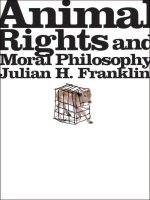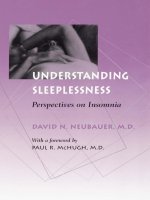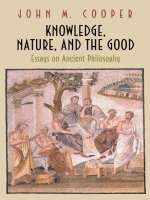open university press understanding psychology and crime perspectives on theory and action sep 2004
Bạn đang xem bản rút gọn của tài liệu. Xem và tải ngay bản đầy đủ của tài liệu tại đây (2.79 MB, 297 trang )
UNDERSTANDING PSYCHOLOGY AND CRIME
Perspectives on Theory and Action
An exceptional book that comprehensively covers the interface between
psychology and criminology…written in an engaging and accessible manner,
nicely linking key themes in order to situate the contribution of psychology to
theories of criminal behaviour, strategies for informed practice, and
contemporary challenges…I cannot recommend this text more heartily.
Dr Ralph Serin, Carleton University, Canada
James McGuire is one of the leading international experts on what works
in reducing reoffending, and he has written an extremely valuable and
accessible textbook a clearly written, well-researched and up-to-date survey of
important contributions of psychology to key criminological issues. It is
especially noteworthy for its illuminating reviews of cognitive–social learning
theories, risk factors and longitudinal studies, risk assessment, cognitive–
behavioural programmes and meta-analyses of treatment effectiveness.
Professor David Farrington, Institute of Criminology,
University of Cambridge
• What contributions can psychology make to our understanding of crime?
• How can psychological models and research help to prevent crime and reduce
repeat offending?
This highly readable book discusses the complex relationships between
psychology, criminology and criminal justice. Challenging the assumptions of
those who object to the use of psychology within criminology, this book shows
how a methodical approach to the study of criminal behaviour can generate
both systematic findings and practical solutions to problems.
McGuire argues for a broader understanding of crime, based on factors such as
the individual’s cognitive and emotional development, in addition to the
influences of socialization, peer groups, and the social and economic
environment. He highlights the value of understanding ‘pathways’ to offending
behaviour, and the critical points at which choices are made.
Topics include:
• Theoretical and empirical research foundations of ‘criminogenic risk factors’
• Theory turned into practice – the development of offending behaviour
programmes
• A psychological perspective on some core concepts in criminology:
retribution, deterrence and incapacitation
• Major practical applications of psychology in policing, prosecution and
sentencing
This authoritative and stimulating text is essential reading for students in
criminology and psychology, and for criminal justice practitioners and policy
makers.
James McGuire is Professor of Forensic Clinical Psychology at the University of
Liverpool, UK. His previous publications include Offender Rehabilitation and
Treatment: Effective Programmes and Policies to Reduce Reoffending (2002) and
Behaviour, Crime and Legal Processes: A Guide for Forensic Practitioners (2000).
Cover illustration: Linda Combi
Cover design: Barker/Hilsdon
9 780335 211197
ISBN 0-335-21119-4
www.openup.co.uk
James McGuire
Understanding psychology and crime
McGuire
Series editor: Mike Maguire
Understanding
psychology and crime
Perspectives on theory and action
Understanding psycho-crime pb 8/3/04 4:45 PM Page 1
Understanding psychology and crime
Perspectives on theory and action
CRIME AND JUSTICE
Series editor: Mike Maguire
Cardiff University
Crime and Justice is a series of short introductory texts on central topics
in criminology. The books in this series are written for students by
internationally renowned authors. Each book tackles a key area within
criminology, providing a concise and up-to-date overview of the principal
concepts, theories, methods and findings relating to the area. Taken as a
whole, the Crime and Justice series will cover all the core components of an
undergraduate criminology course.
Published titles
Understanding criminology 2nd
edition
Sandra Walklate
Understanding justice 2nd
edition
Barbara A. Hudson
Understanding social control
Martin Innes
Understanding risk in criminal
justice
Hazel Kemshall
Understanding youth and crime
Sheila Brown
Understanding crime data
Clive Coleman and
Jenny Moynihan
Understanding white collar
crime
Hazel Croall
Understanding crime prevention
Gordon Hughes
Understanding violent crime
Stephen Jones
Understanding community
penalties
Peter Raynor and Maurice Vanstone
Understanding psychology and
crime
James McGuire
Understanding psychology
and crime
Perspectives on theory and action
James McGuire
Open University Press
Open University Press
McGraw-Hill Education
McGraw-Hill House
Shoppenhangers Road
Maidenhead
Berkshire
England
SL6 2QL
email:
world wide web: www.openup.co.uk
and Two Penn Plaza, New York, NY 10121-2289, USA
First published 2004
Copyright © James McGuire 2004
All rights reserved. Except for the quotation of short passages for the purposes of
criticism and review, no part of this publication may be reproduced, stored in a
retrieval system, or transmitted, in any form, or by any means, electronic, mechanical,
photocopying, recording or otherwise, without the prior written permission of the
publisher or a licence from the Copyright Licensing Agency Limited. Details of
such licences (for reprographic reproduction) may be obtained from the Copyright
Licensing Agency Ltd of 90 Tottenham Court Road, London, W1T 4LP.
A catalogue record of this book is available from the British Library
ISBN 0 335 21119 4 (pb) 0 335 21120 8 (hb)
Library of Congress Cataloging-in-Publication Data
CIP data has been applied for
Typeset by RefineCatch Ltd, Bungay, Suffolk
Printed in the UK by Bell & Bain Ltd, Glasgow
Contents
Series editor’s foreword ix
Preface xiii
1 Why psychology? 1
Defining crime 3
Ordinary crime 5
Criminology: the case of the missing person 7
The scientific approach 9
The assumed philosophical basis of psychology 10
Positivism 10
Individualism 12
Biologism 14
Determinism 15
Reductionism 17
Psychology’s task 18
Historical roots 19
The structure of psychology 21
The relation of psychology to law 23
Further reading 25
2 Accounting for crime 27
Main concepts in criminological theory 28
Levels of description 30
Level 1: macro-level accounts 31
Level 2: locality-based accounts 33
Level 3: socialization and group influence processes 34
Level 4: crime events and ‘routine activities’ 35
Level 5: individual factors 35
Psychological processes in sociological models 38
Theory integration 41
Integrative developmental models 42
Evolutionary frameworks 45
Origins of (cognitive) social learning theory 48
The study of cognitive development 50
The cognitive–social learning synthesis 52
Further reading 53
3 Psychological processes in crime 55
Basic processes 56
Theory ‘from the ground up’ 58
Interrelationships of thoughts, feelings and behaviour 59
Information processing 60
Interactionism 62
‘Ordinary’ behaviour 65
Everyday habits and routines 66
Self-regulation: functional and dysfunctional 68
The example of anger 69
Psychological processes and individual differences 71
Further reading 73
4 Pathways to offending behaviour 75
Property offences 76
Interpersonal contexts of property offending 78
Moods, cognitions and crime 81
Personal violence 82
Family interactions 85
Situational factors and social signals 88
Cognition and violence 89
Substance use and social learning 92
Sexual offending 96
Further reading 100
5 Individual factors in crime 101
Longitudinal studies 107
Developmental pathways 108
Synthesizing research findings 112
Discovering risk factors through meta-analysis 113
Identifying risk factors through evaluation of outcomes 115
Specific risk factors? 118
Two patterns of offending? 120
Offenders with mental disorders 122
Problems of definition 122
Mental health problems in offenders 123
Mental disorder and risk of offending 124
Personality disorder 126
Individual differences: practical implications 127
Risk assessment 128
vi Understanding psychology and crime
Risk assessment and mental disorder 130
The context of risk assessment 131
A framework for crime prevention 132
Further reading 133
6 Preventing and reducing crime 134
Background to the debate 135
Discovering ‘what works’ through meta-analysis 136
Main features of the reviews 138
Ground covered 139
Limitations of the reviews 144
General impact 145
Patterns in effect sizes 147
Factors contributing to effectiveness 148
First the down side 148
Structured programmes 150
Features of ‘likely to succeed’ services 151
Methods of working 154
Young offenders 154
Adults 159
Driving offences 160
Property offences 161
Substance abuse 162
Violent offences 163
Sexual offences 166
Treatment approaches for offenders with mental disorders 167
Further reading 170
7 Crime and punishment: a psychological view 171
Key concepts in sentencing and punishment 173
Retribution 173
Incapacitation 174
Deterrence 174
Evidence for deterrence effects 176
The impact of sentencing 177
Imprisonment and crime rates 179
Enhanced punishments 180
Meta-analytic reviews 182
Deterrence on (controlled) trial 182
Self-report surveys 184
The death penalty 185
The failure of punishment 186
Strategies and methods of behaviour change 187
Behavioural analysis of punishment 187
Cognitive factors 189
Deterrence effects 193
Contents vii
Ineffective – but indispensable? 196
Further reading 197
8 Applications and values 199
Psychology and the criminal justice process 200
Police investigation 200
Gathering evidence: the testimony of witnesses 201
The sentence of the court 202
Implementation: organizational and social contexts 204
Costs and benefits of interventions 204
Integrating psychology and law: therapeutic jurisprudence 205
Professional organizations 207
Psychology and crime: the social context 208
Individual and community 209
Ethical dilemmas: risk assessment, prediction and change 210
Professional codes of ethics 212
Augmenting models: risk factors and good lives 212
Desistance: the whole person 213
Psychology, science and politics 214
Polemics of criminal justice 215
Psychology and the sociology of science 216
Further reading 218
Glossary 219
References 226
Subject index 265
Name index 273
viii Understanding psychology and crime
Series editor’s foreword
James McGuire’s book is the eleventh in the successful Crime and Justice
series published by Open University Press. The series is now established as
a key resource in universities teaching criminology or criminal justice,
especially in the UK but increasingly also overseas. The aim from the outset
has been to give undergraduates and graduates both a solid grounding in
the relevant area and a taste to explore it further. Although aimed primarily
at students new to the field, and written as far as possible in plain language,
the books are not oversimplified. On the contrary, the authors set out
to ‘stretch’ readers and to encourage them to approach criminological
knowledge and theory in a critical and questioning frame of mind.
James McGuire has been a leading figure in the ‘What Works’ debates
that have been increasingly prominent in the criminal justice arena over the
last ten years, especially in relation to the development of cognitive-
behavioural programmes, which aim to encourage and assist offenders on
probation or in prison to understand and address their offending
behaviour. Naturally, he covers these issues in this book in considerable
depth, but his aims here are much broader. In essence, he sets out to assess
the contribution that psychology can make, and has made, to knowledge
and practice in the fields of criminology and criminal justice. As he points
out, there has been something of a ‘divorce’ between psychologists and
criminologists since the 1970s, when sociological approaches began to
dominate academic criminology (in Britain, at least) and psychological
approaches were criticized, as part of a major attack on ‘positivism’, for
excessive focus on individual pathology at the expense of attention to
broader structural forces in society.
However, as McGuire shows, ‘psychology’ is an infinitely richer and
more complex subject than has been portrayed in many of the cruder
attacks on its relevance to the study of crime, and psychologists adopt
a wide variety of theoretical approaches which should be of core interest
to criminologists. Moreover, psychology has been making a serious
‘comeback’ in the criminal policy and practice arenas, not just in the ‘What
Works’ developments in prisons and probation, but through major con-
tributions in policing (especially serious crime investigation), criminal
evidence to courts, risk assessment, and early interventions with children
and families. As a result, many more opportunities are opening up in the
criminal justice field for graduates with some knowledge of psychology.
This is increasingly being recognized by those running undergraduate and
postgraduate degrees in criminology, and more and more modules with a
strong psychological slant are being developed. Degrees and courses in
forensic psychology, too, are expanding rapidly in universities. This book
will be of value to students on all the above.
The book begins with a broad overview of the relationship between
psychology and the study of crime, at the same time laying to rest some
myths about the assumed philosophical basis of psychology. In Chapters 2,
3 and 4, McGuire argues that the study of individual factors, including
cognitive and emotional development, should be seen as one (important)
element of a broader understanding of crime, which should include the
influences of socialization and peer groups as well as the broader social and
economic environment. He also highlights the value of understanding
‘pathways’ to offending behaviour, and the critical points at which choices
are made. Chapters 5 and 6 cover the theoretical and empirical research
foundations upon which the identification of ‘criminogenic risk factors’
has been built, and show how the theory has been turned into practice
through the development of offending behaviour programmes. Chapter 7
offers a much broader survey of what psychology has to say about some of
the core concepts with which criminologists and penologists have wrestled
over the years, including retribution, deterrence and incapacitation. Chapter
8 looks at some of the major practical applications of psychology in
policing, prosecution and sentencing. It also raises some of the important
ethical and political questions to which they give rise.
Overall, the book offers a rich and wide-ranging – as well as very read-
able – discussion of the complex relationships between psychology,
criminology and criminal justice policy and practice. It demonstrates how
important it is to understand practice and policy developments in relation
to their theoretical underpinnings, and should be of major interest to
practitioners as well as to those engaged in academic study.
Other books previously published in the Crime and Justice series – all of
whose titles begin with the word ‘Understanding’ – have covered crimino-
logical theory (Sandra Walklate), penal theory (Barbara Hudson), crime
data and statistics (Clive Coleman and Jenny Moynihan), youth and crime
(Sheila Brown), crime prevention (Gordon Hughes), violent crime (Stephen
Jones), community penalties (Peter Raynor and Maurice Vanstone), white
collar crime (Hazel Croall), risk and crime (Hazel Kemshall) and social
control (Martin Innes). Two are already in second editions and other
second editions are planned. Other new books in the pipeline include texts
on prisons, policing, criminological research methods, sentencing and
x Understanding psychology and crime
criminal justice, drugs and crime, race and crime, and crime and social
exclusion. All are major topics in university degree courses on crime and
criminal justice, and each book should make an ideal foundation text for a
relevant module. As an aid to understanding, clear summaries are provided
at regular intervals, and a glossary of key terms and concepts is a feature
of every book. In addition, to help students expand their knowledge,
recommendations for further reading are given at the end of each chapter.
Mike Maguire
April 2004
Series editor’s foreword xi
Preface
Some years ago, a well-known criminological researcher told me that he
‘had never had much use for psychology’ in his work and implied he could
not see the relevance of it for criminology as a whole. I was at first taken
aback by this, mainly on account of its abrupt and all-embracing dismis-
siveness, and thought it must be an idiosyncratic standpoint. Having
become more familiar with the literature of criminology since then, I now
realize it is a view that is quite widespread. Writers in criminology have
depicted psychology as predominantly positivist in its orientation and have
castigated it accordingly (e.g. Roshier 1989). Psychologists themselves
have commented on how psychological theory and research have been
marginalized and even ‘systematically downplayed’ in mainstream crimin-
ology (e.g. Andrews 1995). Textbooks in the field are evidently much more
influenced by other social science disciplines, most prominently sociology.
That may account for the 22 out of 564 pages devoted to psychology in
the textbook by Conklin (1992), or the even thinner 6 out of 529 pages
allotted by Glick (1995).
The rationale for the present book is not to assuage the feelings of hurt
and rejection that we poor psychologists may feel in this situation, sensitive
though many of us may be! It is instead to examine closely the contribution
that psychology is able to make to understanding the activity we call
‘crime’, and what (if any) practical implications may flow from this. That
activity can be studied using many approaches. At least one of them,
surely, needs to take into account the observation that whatever other
influences may be at play, acts of crime are for the most part committed by
individuals. That is certainly the basis on which the law operates: legal
decision-making attributes responsibility or guilt for crimes to persons;
and while the basis for that may be questioned, there appears little
immediate prospect of it being changed in any meaningful way. Even
where crimes are committed by corporations or other collective entities,
individual decisions are still intimately involved in the process. In a
discussion some years after the one mentioned above, another researcher
proposed that the recorded increase in crimes of burglary in England and
Wales during the years 1980–1982 had been caused by the economic reces-
sion of that period. That may indeed have been an important factor. But
exactly how did it have its effect? Did the perpetrators of the 200,000
additional burglaries assemble in Hyde Park and jointly decide to embark
on a breaking-and-entering spree? Or did their changed circumstances, and
their perceptions of and reactions to them, lead to numerous separate
decisions to commit a property offence, filtered through each individual’s
own psychological processes? Why did many other individuals, also
afflicted by economic hardship, not resort to burglary during the same
period?
There appears to be a widespread assumption that psychology suffers
from a number of flaws that make it inapplicable to the study of crime. Its
practitioners portray themselves as scientific and adopt the same methods
of inquiry as ‘hard’ scientists, like physicists or biochemists. They talk
about behaviour and carry out controlled experiments, at a time when
other social studies disciplines have embarked on a search for novel para-
digms. Psychology is thought to seek explanations for the things people do
more or less exclusively among causes located inside themselves, and to
neglect if not actually ignore external, environmental factors such as social
conditions or political forces. This has been characterized as an intrinsic-
ally conservative stance (Lilly et al. 2002). It appears closely allied to
biology and medicine, and to the idea of crime as a disease. Psychologists
have been known to use rats, pigeons, university students and other exotic
species in their research and they make great claims on the basis of some
fairly narrowly selected samples and outlandish investigations. In some of
their experiments they place people in darkened rooms, make them wear
lenses that turn the visual world upside down, or apply electric shocks to
them. They employ IQ tests, nonsense syllables, one-way mirrors and aver-
sion therapy. Altogether an odd and unsavoury bunch, with whom it might
be better to keep contact to a minimum!
I fully agree: the history of psychology is not entirely wholesome and
laudable. It has been littered with some regrettable ideas and unfortunate
applications (Gould 1981); though in these respects, it is scarcely unique. I
nevertheless am convinced, and hope this book will convince its readers,
that psychology contains a great deal that can be useful to criminology in
terms of theory, research and application. A recent commentary has noted
grounds for a new, potentially more cordial and fruitful relationship
between criminology and psychology than has been in evidence for some
time (Hollin 2002a). Furthermore, like other disciplines psychology has
been steadily evolving, and currently employs a plurality of methodolo-
gical approaches. Most psychologists recognize that the alleged boundaries
between fields of knowledge are subject to shifting and sometimes almost
arbitrary definition, and virtually any given problem will require multiple
perspectives to be amply understood.
xiv Understanding psychology and crime
The present volume is offered in that light. It aims as far as possible to
project a picture of the psychological elements in crime while identifying as
many as possible of the necessary links to other social sciences. This is not
to claim that individual, psychological factors are somehow more import-
ant than those more regularly studied within criminology. Rather, it is an
insistence that if we dismiss or neglect those issues, our ability to compre-
hend the problem of crime will remain inadequate. Only a combined effort
involving theory and evidence from a wide range of sources will help us
towards a fuller understanding.
I am very grateful to several people who have had an enormous influence
on my understanding of the issues discussed in this book. Foremost is
Philip Priestley, to whom I owe an introduction to the field of ‘crime and
justice’ and from whose breadth of knowledge and perspective I benefited
enormously. I am very grateful to Mike Maguire for inviting me to be part
of the series, and for valuable comments on the manuscript. In discussion
at numerous conferences, meetings or advisory panels, I have gained much
from being able to pick the brains of some of the most able people in this
field. Those who have contributed to the book, in different ways and most
often unknowingly, include Don Andrews, Ron Blackburn, Meg Blumsom,
Meredith Brown, David Cooke, David Farrington, Paul Gendreau, Clive
Hollin, Doug Lipton, Caroline Logan, Friedrich Lösel, Mary McMurran,
Frank Porporino, Beverley Rowson, David Thornton and Sheila Vellacott.
None of them of course bears blame for any remaining errors or
deficiencies.
James McGuire
March 2004
Preface xv
chapter one
Why psychology?
Defining crime
Ordinary crime
Criminology: the case of the missing person
The scientific approach
The assumed philosophical basis of psychology
Positivism
Individualism
Biologism
Determinism
Reductionism
Psychology’s task
Historical roots
The structure of psychology
The relation of psychology to law
Further reading
The history and theory texts generally trace the formal study of crime, and
the origins of the discipline of criminology, to the first half of the nine-
teenth century, making it somewhat less than 200 years old. Of course,
there is no single documented moment when anyone announced that he or
she had just invented a new discipline with such a purpose explicitly in
mind. That seems a real pity. The history of ideas would be much more
easily written if such moments occurred.
The book you are reading now is devoted to a specific aspect of crimin-
ology, or a particular approach within it, informed by psychological theory
and research. It is fair to acknowledge from the outset that criminology
and psychology have not always had an easy relationship (Hollin 2002a).
The pivotal reason for this probably resides in psychologists’ perceived
over-emphasis on the individual, while many criminologists think of crime
as something that can only be understood in terms of social conditions and
society-wide trends.
But there are several other aspects to this, which we will explore more
fully in this opening chapter. In the remaining chapters of the book, my
intention is to outline what, in my view, is the contribution that psychology
can make to a number of key questions in criminology. Overall the book is
planned as follows. The present chapter is designed to set the scene for the
rest. It first of all addresses the question of how crime can be defined. It
then provides some background for thinking about the relationship
between psychology and criminology, and gives some general information
on psychology for readers newly acquainted with it. Chapter 2 considers
the relationship between societal, ecological, situational and individual/
psychological factors in helping to explain the occurrence of criminal acts.
This involves an excursion into criminological theory, reviewing the prin-
cipal directions it has taken and the contribution that psychology might
make to them. Chapter 3 focuses in more depth on a ‘psycho-social’ model
of individual action and development and how it may be used to under-
stand the emergence, and in some instances the persistence, of patterns of
behaviour that are labelled ‘criminal’. Chapter 4 will apply this model to
provide a more detailed picture of how psychology can contribute to an
understanding of the occurrence of four specific kinds of offending
behaviour: property crime, personal violence, substance abuse and sexual
offending. Chapter 5 takes this one stage further by identifying factors
thought to play a part in the development of criminal involvement, now-
adays often discussed within what is called a ‘risk–needs’ framework.
Though most people break the law at some time in their lives, a relatively
smaller number of them show patterns of repeated offending and are
responsible for a fairly large portion of reported crimes. This chapter will
also consider what, if any, is the relationship between crime and mental
disorder. Chapter 6 turns attention to several kinds of interventions that
have been shown to be useful and to have positive outcomes in reducing
criminal recidivism. This will entail collating evidence from large-scale
reviews of the outcomes of different types of work with offenders. These
findings are perhaps one of the main reasons for a recent resurgence of
interest in psychology within criminology itself. Chapter 7 addresses the
main response society currently makes to offenders: the use of punishment
or ‘deterrent sanctions’. Despite its widespread use, this appears to be
remarkably unsuccessful in achieving its intended goals. Can psychology
help us to understand this apparent paradox? Finally, in Chapter 8, we
will consider a number of practical applications of psychology, and
some ethical and political aspects of a psychologically informed approach
to the study of crime. This will include the core question of whether a
scientific approach to these and other questions can be compatible with a
value-based system grounded in social justice.
2 Understanding psychology and crime
Defining crime
Some of the recent debates in criminology have centred on the very defini-
tion of crime itself. What exactly is it? On one level this might sound
like an empty, time-wasting question. Surely crime can be easily defined
as any activity publicly proscribed by the written laws of a society. Thus,
specified acts like speeding, criminal damage, theft, fraud and assault
are all defined and prohibited within the statutes of the criminal law. So far
so good: but if you want to study these actions and understand their
patterning, the apparent simplicity of this definition can be very mislead-
ing. Criminologists agree that the process of researching crime is made
extremely difficult by the complex relationship that exists between acts
that are formally demarcated in this way, and the information that is gen-
erated about them by the activities of citizens, police, courts and the penal
system. The statistics of recorded crime are notoriously difficult to inter-
pret (Walker 1995; Coleman and Moynihan 1996; Maguire 2002), even in
societies where this process has been established in some form for several
hundred years.
Thus there are many uncertainties regarding the overall rate of crime in a
society. Furthermore, conceptions of crime vary between different com-
munities and societies. They also change over time. These differences show
for example even in very straightforward ways, such as the age at which
young people are held to be criminally responsible (and can therefore be
convicted of an offence). Even within the United Kingdom this varies: 8 in
Scotland, 10 in England and Wales. These figures are generally lower than
in other European countries; although it is 7 in Ireland, corresponding ages
elsewhere are 13 in France, 14 in Germany, 15 in Sweden and 16 in Spain.
As a more specific example, within different European countries there
are variations in law regarding the possession of cannabis. In England
and Wales, rates of arrest for this offence have recently shown a decline
(May et al. 2002). The reclassification of the drug from Class B to Class C
with effect from January 2004 will have a more marked effect, literally by
changing what then constitutes a ‘crime’.
A more serious example is the offence of marital rape. Under English
common law doctrine that had stood since the eighteenth century, it was
presumed that the contract of marriage permitted husbands irrevocable
consent for sexual intercourse with their wives (provided they were living
together), so affording legal immunity from a charge of rape. Following a
judicial ruling in 1992, such behaviour was redefined, a change then
incorporated in the Criminal Justice and Public Order Act of 1994 (Reed
and Seago 1999). This reversed a period of over 200 years during which it
was not deemed to be illegal. Looking farther afield it is possible to find
behaviour with even more drastic consequences. The Mundurucu people
of the South American rainforest regard the birth of twins as a disturbing
indication of regression to an animal state (as species other than ourselves
Why psychology? 3
more often have multiple births). In Mundurucu society, such babies are
killed, but no law is broken as a result (Sanday 1981).
Thus, acts that are labelled as crime in some circumstances are not so
defined in others: ‘there is no behaviour which is always and everywhere
criminal’ (Phillipson 1971: 5). Contemplating this, we become unsure of
what exactly comprises a crime, and whether this can be delineated in any
sense ‘objectively’. It becomes apparent that crime is a socially constructed
phenomenon, in a stronger sense than the one implicit in the idea that it
consists of what is written down in codes of law.
In a discussion of this conundrum, Muncie (2001) has identified as many
as eleven separate definitions of crime. Some revolve around the familiar
idea of criminal law violation, or variations on that theme. Others are
couched in the broader context of departures from moral and social codes.
Still others locate the sources of definition itself within the power structures
of a society, and widen the purpose of criminology to include the study of
the processes by which such definitions are manufactured. The most elab-
orate definitions focus on the doing of harm, and subsume any of a wide
range of circumstances in which individuals are denied rights as a result of
actions or events within social relationships and systems. Such definitions
encompass many types of behaviour not ordinarily considered crimes.
They include, for example, disregard of safety standards in the workplace,
the marketing of tobacco products in the light of evidence of their harm-
fulness, deliberate acts of environmental pollution, and covert arms sales
to despotic regimes. ‘Legal notions of “crime” do seem to provide a pecu-
liarly blinkered vision of the range of misfortunes, dangers, harms, risks
and injuries that are a routine part of everyday life’ (Muncie 2001: 21). In
ideological terms, defining ‘crime’ in certain ways and directing public
attention towards it has the useful benefit of distracting attention from
other acts that serve the purposes of powerful interest groups.
These considerations have an important bearing on the status of psycho-
logical research and how it is perceived within criminology. For it must be
admitted, psychologists have tended to accept broadly traditional and
what might be called ‘official’ notions of what constitutes crime. By and
large, therefore, they have concentrated their efforts on the study of acts
customarily regarded as unlawful in Western societies, such as offences
against persons, violent and sexual assaults, and the illicit use of controlled
drugs.
That is arguably, however, not an unreasonable way to proceed, and it is
possible to exaggerate the extent of cultural variations in how crime is
defined. International surveys suggest there is a sizeable consensus in the
unacceptability and condemnation of certain acts. Newman (1976, 1977)
carried out a study in which he asked people in six countries whether
certain acts should be prohibited by law, and to rate the seriousness of
them. The countries were the USA, Italy, Yugoslavia (as it then was), Iran,
India and Indonesia. Newman presented respondents with brief vignettes,
describing for example actions in which:
4 Understanding psychology and crime
• One person forcefully takes money from another, who requires hospital-
ization as a result.
• A father has sexual relations with his grown-up daughter.
• Someone uses illegal drugs (the named substance varying from one
culture to another).
• Managers permit toxic gases to be released from a factory into the
atmosphere.
There was a very high level of agreement in terms of how these actions
were viewed, in perceptions of them as crimes, and in the ranking of their
relative seriousness.
Criminological psychologists have concentrated their efforts on studying
crimes defined in these more-or-less conventional terms. To date at least,
they have had little or nothing to say about those acts that would be
included within Muncie’s (2001) widest definitions. There is very little
psychological research on corporate crime or money laundering, on the
dumping of toxic waste, the traffic in human slaves, the illegal sale of
torture equipment, or the theft of plutonium from nuclear plants. Several
types of psychological research are potentially relevant to these areas, but
to date the connections have not been made. There is psychologically
informed work on some crimes that can only be understood in their
broader political context, for example on genocide (Staub 1989). Within
this book, however, we will focus on the potential usefulness of psychology
for making sense of crimes of the more familiar, ‘ordinary’ type.
Ordinary crime
Arguments regarding the need to think carefully about what we mean
when we use the word crime are perfectly valid, and very powerful. It
remains important, however, not to lose sight of many of the basic actions
and events that constitute the stuff of most criminological theorizing and
research. Let us therefore begin with a proposal that, whatever may be the
sources of error in our various devices for recording and analysing crime,
there is an underlying pattern of actual events that genuinely occurred ‘out
there’. For the purposes of the present book, that means adopting a
broadly realist approach to this problem. This is grounded in the observa-
tion that there are certain things that people sometimes do to others, which
are resented by them or by their wider social group. To borrow a distinc-
tion from the philosopher John Searle (1995), these are what could be
regarded as some of the ‘brute facts’ of human behaviour. Once they have
been codified in a socially constructed set of documents, which cumu-
latively form what we call the criminal law, they become what Searle calls
‘institutional facts’. Undoubtedly, what is subsumed by the latter evolves
over time. It shows inter-cultural variations, and often serves the interests
Why psychology? 5
of some strata of society more than others. The selection of some types of
harm that are then depicted as crime reflects many wider social and
political agendas. Hence, it may be impossible for us ever to have a fixed
definition of crime, or to have a comprehensive knowledge of its under-
lying patterns. The different actors involved in any given crime event may
have discrepant views of what took place, and we have no reliable way of
knowing how frequently or in precisely what pattern such events occurred.
Consider the following examples of what most people would convention-
ally regard as criminal acts. All were committed and the respective offenders
prosecuted under the laws of England and Wales within recent years.
• Paul, aged 15, was arrested a number of times for vehicle theft. On several
occasions, this followed high-speed car chases by the police, exceeding
80 miles per hour on ordinary roads, in one of which he received injuries
requiring hospital treatment.
• Sheryl, aged 16, was convicted of a series of shop thefts. She had regu-
larly made money by selling bottles of whisky or other spirits she had
stolen from supermarkets or smaller stores. On one occasion she walked
unchallenged through a checkout with a case of twelve bottles.
• Earl, aged 17, was arrested following an altercation in a mobile phone
shop. He made threats to a member of the staff who believed he was in
possession of a weapon and called the police.
• Anthony, aged 18, assaulted a youth worker who attempted to inter-
vene in a fight between him and another youth. The intended victim had
earlier shouted obscenities at Anthony’s younger sister, towards whom
he felt very protective.
• Graham, aged 21, was sent to prison for supplying Class A drugs. At
the request of a supposed friend, he passed a number of bags of heroin
direct to two customers – who, it transpired, were police officers working
under cover. He denied knowing what the bags contained.
• Trevor, aged 35, was placed on probation with a requirement that he
attend a domestic violence programme, after admitting to and being
convicted of a series of assaults on his wife.
You will have noticed that four out of the six people mentioned in the
above vignettes are in their mid- to late-teens. It is a familiar finding among
the crime statistics in many countries that those years represent the peak
age for involvement in law-breaking activities. Five of the six individuals in
the list are male; five are white. Criminal activity, at least as recorded in the
high-technology nations where criminology is most widely practised, is
predominantly (though by no means exclusively) engaged in by young white
males. This raises the question of how far any findings obtained about that
group, and any theory construction based on them, is applicable to other
groups. (Such a criticism has also been levelled, with ample justification, at
some of the findings and theories produced within psychology.)
But this pattern of activity is not one that conforms to the picture many
people have of crime, if their impressions of it have been gleaned from the
6 Understanding psychology and crime
daily press, through watching television dramas or reading ‘true crime’
paperbacks. Felson (2002) has pointed out how the most widely spread
perceptions of crime are subject to a number of serious misunderstandings
or fallacies. For example, many people picture criminal acts as exciting or
dramatic in content and filled with action and suspense. There are prob-
ably large amounts of money, jewellery, drugs or maybe even lives at stake.
Criminal acts are ingeniously planned, and skilfully and daringly executed.
Successful British criminals take up residence in Spain or Brazil where they
become even wealthier by running night clubs or casinos.
And, of course, there are criminal acts that are highly organized and
likely to yield a better payoff than the ones itemized earlier. Carrabine et al.
(2002: 96) have compiled a useful table listing some of the more notorious
examples of recent years. They include the major scandals surrounding the
companies Guinness-Distillers, Barlow-Clowes, Polly Peck and the Bank of
Credit and Commerce International (BCCI). In each of them, enormous
sums of money were misappropriated, exceeding the total amount stolen in
all ‘ordinary’ thefts and burglaries for the corresponding years (Maguire
2002). In some instances, the perpetrators were never successfully brought
to justice.
But while a small proportion of crimes may conform to these descrip-
tions, the vast majority by contrast are ordinary, unspectacular events.
They involve little or no prior planning; minimal effort is expended; the
stakes are fairly modest. Almost the only aspect of media portrayals of
crime that is accurate is that the majority of the actors cast in criminal roles
are male.
At the same time, many people are hurt by crime, and many more live in
fear of it, whether or not they have directly come into contact with it. To be
a victim of a minor crime may cause only limited inconvenience, but is
nevertheless an unpleasant and irritating experience. To be verbally threat-
ened or to encounter an intruder in your home can be extremely frighten-
ing. Some assaults result in long-term physical and emotional damage.
Serious or repeated victimization can cause significant, profound and
enduring distress in people’s lives. Whatever our definitions of crime, and
however much academic debate there may be in relation to them, such
events happen. Such reactions to them are not uncommon.
That fallacies like the ones described by Felson (2002) persist, and that
the fear of crime bears only an indirect relationship to objectively measur-
able risks of it (Mirrlees-Black and Allen 1998) is, perhaps, a testimony to
the power of the media, or of crime novels, in portraying criminal acts.
Criminology: the case of the missing person
Felson’s own principal contribution to criminological thought, routine
activity theory, manifests some interesting features that are of pointed
Why psychology? 7
relevance to the objectives of the present book. Though comparatively
recent in origin, it has already become a well-established approach to the
study of crime, regarded by some reviewers of the field as a form of ‘right
realism’ (Walklate 1997). Within the theory, crimes against property –
direct contact predatory violations – are thought likely to occur when there
is an intersection in time and space of three vital ingredients: (a) a motiv-
ated offender, (b) a suitable target and (c) the absence of capable guardians.
While researchers on this topic have expended considerable effort in speci-
fying the features of the latter two variables in detail, the first is deliberately
left to one side. In the original version of the theory, ‘persons were treated
virtually as objects and their motivations were scrupulously avoided as a
topic of discussion’ (Clarke and Felson 1993: 2).
The present book is an attempt to fill that void: not with respect solely
to routine activity theory itself, but more broadly across criminology in
general. I hope to show how a balanced, integrative approach to the study
of persons, taking account of their histories and of the situations in which
they are acting, can help us build a richer, better informed model of what
happens when crimes occur.
When hearing of a crime, most people probably assume that the person
accused of it had some plausible reason or motivation for acting as he or
she did. Media accounts of crime appeal to those assumed motives, though
unsurprisingly the type of explanation offered varies according to the
nature of the crime. Motivations for property crime may be thought to be
self-evidently attributable to acquisitiveness, and whether this is believed
to arise from ‘greed’ or ‘need’ may depend on the offender’s circumstances.
A proportion of crimes appears to be driven by strong ‘passions’, such as
anger, hatred, jealousy or vengefulness. Such factors too are comprehen-
sible to most of us; especially if alcohol or other drugs are involved, since
they are widely viewed as loosening personal controls. If none of these
motives is apparent, people may be puzzled by an act, but still naturally
seek to understand it. Crimes might then be ascribed to more vaguely
defined causes with no real explanatory value. Some are described as
‘mindless’, while more serious violent crimes are portrayed as resulting
from a larger, malevolent presence or force: the word ‘evil’ may be applied.
But research on common-sense or ‘lay’ theories of crime suggests that
people employ more complex models of causation than is generally pre-
supposed (Furnham 1988). Typically, criminal acts are not viewed as a
product of any single motive, and the extent to which the vocabulary of
‘motive’ is used may depend on the observer’s own position in society.
The central argument of this book is that to understand the kinds of
events listed earlier, a wide range of influences needs to be taken into
account. They include historical and cultural processes, social environment
and family background, individual factors, and personal circumstances.
There is a constant interplay between them. Their respective roles in rela-
tion to any single act of crime may be very difficult to discern. The contri-
butions of these different factors to crime events may also vary from one
8 Understanding psychology and crime









